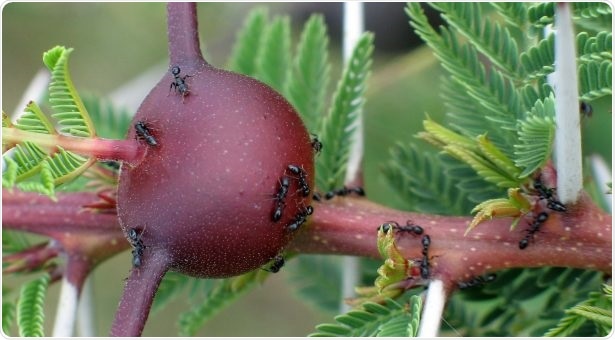Researchers have leveraged gene-editing advances to obtain a 10 times increase in the development of super-bug targeting formicamycin antibiotics.

Tetraponera penzigi, a species of African ant uses antibiotic-producing Streptomyces formicae bacteria to protect them against disease. Image Credit: Dr Dino J. Martins.
Scientists from the John Innes Centre applied the technology to produce a novel strain of Streptomyces formicae bacteria that excessively produces molecules, which are medically promising.
Formicamycins were discovered within the last decade and they have excellent potential because superbugs, such as MRSA, do not become resistant to them under laboratory conditions.
But Streptomyces formicae can create the antibiotics only in limited amounts. This has made it hard to scale up purification for additional investigations and is a barrier to the molecules being advanced for clinical trials.
In a recent study, the team employed CRISPR/Cas9 genome editing to create a strain that produces tenfold more formicamycins on agar plates and also much more in liquid cultures.
Through DNA sequencing, the team found that the formicamycin biosynthetic gene cluster contains a total of 24 genes and is regulated by the activity of three primary regulators within the cluster.
The researchers used CRISPR/Cas9 genome editing to modify the regulatory genes and assessed the amount of antibiotics that were created.
In CRISPR/Cas9 genome editing, a part of a microbial immune system is used to make targeted changes in DNA. By revealing the roles of the three key regulators, the researchers were able to integrate mutations to boost production.
The team also added an additional copy of the formicamycin boosting genes (forGF), successfully placing the foot on the accelerator and eliminating the brake by deleting the repressor gene (forJ).
Remarkably, when the team lifted the brake, ForJ, formicamycins were produced in liquid culture, which had not been possible before and this was an obstacle to scaling up the synthesis of these useful compounds. In addition, the same activity resulted in the production of different formicamycin variations with potential antibiotic activity against MRSA.
Formicamycins are promising and powerful new antibiotics and we have used gene editing to generate a strain which over-produces these molecules. This will allow us to understand how they work and determine if they have the potential for clinical development.”
Dr Rebecca Devine, Study First Author, John Innes Centre
The target for the following steps of the study is to further interpret the regulation of formicamycin biosynthesis, since some of the gene deletions used to obtain the new strain had surprising effects.
There is still a lot to learn and we may be able to increase production even further when we’ve figured this out.”
Matt Hutchings, Study Author, Group Leader, and Professor, John Innes Centre
Hutchings continued, “We will use the over-producing strain to purify enough formicamycins to figure out their mode of action, how they kill superbugs such as MRSA, and why these superbugs don’t become resistant. This is vital to their further development as antibiotics.”
Streptomyces formicae is a bacterial strain that is present in the nests of Tetraponera penzigi, a kind of African ant species. The antibiotic-producing bacteria ants are used by ants to guard themselves and their source of food from pathogens.
As such, 50% of all familiar antibiotics are acquired from the specialized Streptomyces bacteria metabolites, the majority of which were found over six decades ago in the Golden Age of antibiotic discovery.
Meanwhile, some new classes of antibiotics have been introduced, raising the risk posed by antimicrobial resistance. There is urgent need for antibiotics that can destroy the supposed superbugs, such as methicillin-resistant Staphylococcus aureus (MRSA).
Professor Hutchings’ group work was performed in association with Professor Barrie Wilkinson from the John Innes Centre. The latest purchase of natural products chemistry equipment, thanks to a successful capital expenditure bid to BBSRC, will considerably improve the potential to scale up the synthesis of formicamycins in the next stage of this project, concluded Professor Wilkinson.
Source:
Journal reference:
Devine, R., et al. (2021) Re-wiring the regulation of the formicamycin biosynthetic gene cluster to enable the development of promising antibacterial compounds. Cell Chemical Biology. doi.org/10.1016/j.chembiol.2020.12.011.